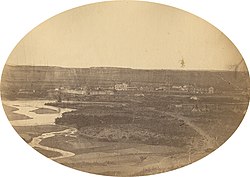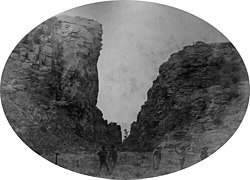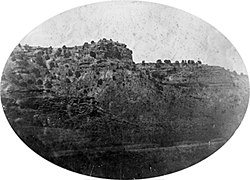181:'s staff. Among the instructions that Simpson left for Smith was specific guidance for the expedition's artists. "Photographic pictures of as many prominent scenes as possible will also be taken," Simpson wrote, "including Fort Kearney, Court House & Chimney Rocks, Fort Laramie & every other proper object or scene." Later on the trail, Simpson sent back instructions for Smith to get a good view of Ash Hollow, noting that such "would make a fine illustration for the report." He again emphasized the importance of securing "as many views taken of remarkable topographical and geological features of the region traversed as possible... even if the party is delayed by it."
290:
400:
388:
260:
275:
245:
430:
work. Meanwhile, he studied law, passed the bar in 1872, and was appointed as a police judge in the district, a position he held for the remainder of his working life. In later years, Mills was an active member of the Grand Army of the
Republic and the Masonic Order. The hard-learned lessons of his youth regarding alcohol may have been the impetus for his founding the Sons of Jonadab, a temperance organization. Samuel Mills died on October 7, 1911, and was buried in the
159:
170:
departed in April 1858 and camped for a month at Fort
Leavenworth to complete their planning and to test out their equipment. The wood crates packed with instruments, including their new camera, arrived on April 28. Captain Simpson noted in his diary that Mills and Jagiello were soon practicing, producing views of an artillery battery at the post. Among Mills and Jagiello's surviving photographs are three views of buildings at Fort Leavenworth.
230:
28:
348:
glass." Now inside their simple darkroom, they began creating paper prints from the negatives. In addition, Simpson had one of his young subordinates, Lieutenant
Haldimand S. Putnam, create a detailed map of Camp Floyd while he instructed Mills to take a number of views of this sprawling military encampment, at that time the largest military garrison in the country. Mills and his assistant produced a number of views of Camp Floyd.
218:
333:
416:
352:
become too incapacitated to perform his official duties. Finally on Jan. 19, 1859, following another incident at Camp Floyd, Simpson terminated Mills' employment with the expedition "to protect the
Government and myself from imposition and wrong." Mills pleaded for another chance and the officer finally acquiesced but with a stern warning against any further violations.
202:
305:
359:. "The council broke up harmoniously, the Indians shaking hands, &c," Simpson noted in his diary. "They then adjourned to the photographic room where I had their likenesses taken in a group." The following day, Mills produced a portrait of Arapeen and at least one view of the delegation standing in front of a Sibley tent.
370:
Simpson's party returned to Camp Floyd in early
September 1859 and they soon began their return journey to the east coast, taking Mills with them. No photographs from this portion of the trip are known, suggesting that the camera and equipment had been packed away. The delicate glass plate negatives
362:
Looking back later upon his photographic experiment, Simpson characterized it as a failure. "The cause lies in some degree in the difficulty, in the field, at short notice, of having the preparations perfect enough to insure good pictures," Simpson wrote in his final report, and "chiefly in the fact
351:
By early 1859, Simpson was increasingly concerned about his rapidly dwindling supply of photographic chemicals as well as about the dependability of his young photographer. A teetotaler himself, Simpson had become impatient with Mills' drinking habits and warned him on several occasions after he had
169:
In late March 1858, Captain
Simpson submitted a request to hire a photographer at $ 40 per month and an assistant photographer at $ 25 per month, exclusive of their traveling expenses. He then hired twenty-five year old Mills as his expedition photographer and Edward Jagiello as his assistant. They
429:
After his return to D.C., Mills went back to work at Paige's studio on
Pennsylvania Avenue. As the Civil War began, he was busy taking portraits of soldiers in the wartime capital. In 1864, Mills enlisted in the Union Army as a hospital steward and after the war ended, he returned to photographic
347:
As the survey team finally settled in at Camp Floyd for the winter, Mills and
Jagiello were provided with a room for use as a photographic studio in one of the numerous adobe and wood structures just built at the post. Up to this point, the photographers had only produced "negative impressions on
184:
Lieut. Smith's small survey party complied. "Stopped at Court House Rock on our road today," wrote one of the members of the expedition in his diary on July 25, "and Mills (the photographer) took a picture." Extant images confirm that the photographers produced negatives of a number of important
328:
and they spent several months surveying the boundaries of the new military reservations at Fort
Bridger, Camp Floyd, and Rush Valley. Returning to Camp Floyd, Simpson and his crew then drafted a lengthy report describing the roads of Utah Territory, complete with a detailed map.
399:
122:
Born
October 8, 1833, in Washington, D.C., he was the son of John and Mary Mills. As a young man, he worked in his father's shoe factory. In 1856, he began working in the photography studio of Blanchard P. Paige on Pennsylvania Avenue in D.C.
143:. Simpson decided that one of his first projects would be to remap the main emigrant trail on his way to Utah and to create a new guidebook for the Army and civilian emigrants. Having become interested in the photographs of the
363:
that the camera is not adapted to distant scenery." He concluded that "a good artist, who can sketch readily and accurately, is much to be preferred." In May 1859 as he set off on the next leg of his explorations across the
155:, Simpson decided that he would "illustrated some of the more notable features of the route by photographic impressions." If successful, his would be the first emigrant guidebook illustrated through the lens of a camera.
405:
A Group of Utah Indians, including Arrapene (Sinnearoach), the head chief of the tribe, and Luke, the interpreter, taken on the outskirts of Camp Floyd, looking north west towards the Oquirrah Mountains.
371:
presumably were safely transported to War Department headquarters, though what ultimately became of them is not known. Mills' employment with the government ended upon their arrival back home.
498:(Philadelphia: J. B. Lippincott & Co., 1869) p. 32 mistaken gave the name of the photographer as C.C. Mills, which led later historians astray. Peter E. Palmquist and Thomas R. Kailbourn,
324:, Utah Territory, on September 15, 1858. Simpson immediately sent Smith's party back out to help establish a new road between Camp Floyd and Fort Bridger through Timpanogos or
177:, Captain Simpson turned over the supervision of his topographical party to his most senior lieutenant, J. L. Kirby Smith, while he traveled in advance as a member of General
355:
The following day on Jan. 20, a small delegation of Utes led by the prominent leader and Mormon convert Arapeen, arrived at Camp Floyd to meet the post commander, General
387:
106:(October 8, 1833 – October 7, 1911) was an American photographer, Civil War veteran, and a D.C. judge. He is best known for his 1858 photographs from along the
289:
564:
Report of Explorations Across the Great Basin of the Territory of Utah for a Direct Wagon Route from Camp Floyd to Genoa, in Carson Valley, in 1859
580:
259:
201:
562:
304:
217:
173:
The expedition departed Fort Leavenworth on May 31, 1858, and headed west, with Mills producing photographs along the way. At
274:
553:
367:, Simpson left his photographer behind at Camp Floyd and instead used a sketch artist for the remainder of his expedition.
543:
244:
585:
136:
481:
Ephriam D. Dickson III, "Shadowy Figures About Whom Little is Known: Artists of the Simpson Expedition, 1858-59,"
229:
152:
470:
Wagon Roads West: A Study of Federal Road Surveys and Construction in the Trans-Mississippi West, 1846-1869
185:
landmarks along their route—today the earliest surviving views from along the Oregon-California Trail.
280:
393:
View of Middle Portion of Camp Floyd from 10th Infantry Target, Looking North of East, Jan. 1859.
431:
84:
595:
590:
320:
After three and a half long months on the road, the topographical party finally arrived at
139:, was assigned to the reinforcements being sent to Utah Territory as part of the so-called
8:
544:"Shadowy Figures About Whom Little is Known: Artists of the Simpson Expedition, 1858-59,"
525:
451:
421:
356:
178:
555:
A Route for the Overland Stage: James H. Simpson's 1859 Trail Across the Great Basin
340:
208:
132:
111:
73:
55:
513:
A Route for the Overland Stage: James H. Simpson's Trail Across the Great Basin
574:
500:
Pioneer Photographers of the Far West: A Biographical Dictionary, 1840-1865
325:
295:
265:
250:
148:
107:
95:
374:
364:
235:
174:
144:
158:
332:
321:
140:
188:
27:
415:
502:(Stanford, CA: Stanford University Press, 2000), 323, 402-404.
464:
Barbara Beeton, "James Hervey Simpson in the Great Basin,"
163:
The expedition's instrument wagon near Fort Laramie, 1858.
223:
Camp on Little Blue River, Nebraska Territory, June 1858.
375:
Views Illustrative of Camp Floyd, U.T., January, 1859.
567:(Washington, D.C.: Government Printing Office, 1876).
34:
Samuel C. Mills in Utah, 1858–59. National Archives.
472:(New Haven: Yale University Press, 1964), 146-157.
268:, Nebraska Territory, late July-early Aug., 1858.
572:
468:(Winter 1978) pp. 28-43. W. Turrentine Jackson,
310:Head of Echo Canyon, Utah Territory, Sept. 1858.
189:Views From the Main Emigrant Trail, Summer 1858
126:
558:(Logan: Utah State University Press, 2008).
515:(Logan: Utah State University Press, 2008).
26:
494:Simpson, in his privately published book
315:
414:
331:
157:
466:Montana the Magazine of Western History
573:
298:, Utah Territory, probably Sept. 1858.
549:, vol. 83 no. 4 (Fall 2015), 270–289.
485:, vol. 83 no. 4 (Fall 2015), 270-289.
581:Photographers from Washington, D.C.
13:
283:, Nebraska Territory, August 1858.
14:
607:
253:, Nebraska Territory, July 1858.
496:The Shortest Route to California
419:Judge Samuel C. Mills. Courtesy
410:
398:
386:
339:By Mills, photographer with the
303:
288:
273:
258:
243:
238:, Nebraska Territory, June 1858.
228:
216:
200:
137:Corps of Topographical Engineers
135:, an officer in the U.S. Army's
536:
343:. Courtesy Library of Congress.
518:
505:
488:
475:
458:
444:
337:Surveyors at Camp Floyd, Utah.
165:By Mills. Library of Congress.
117:
1:
437:
211:, Kansas Territory, May 1858.
7:
529:, Oct. 9 and Oct. 11, 1911.
10:
612:
131:In February 1858, Captain
547:Utah Historical Quarterly
542:Dickson, Ephriam D. III,
483:Utah Historical Quarterly
147:by British photographers
127:On the Road to Utah, 1858
91:
80:
62:
41:
25:
18:
586:Pioneers of photography
432:Congressional Cemetery
426:
380:By Mills and Jagiello.
344:
316:At Camp Floyd, 1858-59
166:
85:Congressional Cemetery
418:
335:
194:By Mills and Jagiello
161:
552:Petersen, Jesse G.,
434:in Washington, D.C.
561:Simpson, James H.,
526:The Washington Post
511:Jesse G. Petersen,
452:The Washington Post
422:The Washington Post
427:
357:Albert S. Johnston
345:
341:Simpson Expedition
167:
87:, Washington, D.C.
179:William S. Harney
101:
100:
603:
530:
522:
516:
509:
503:
492:
486:
479:
473:
462:
456:
455:, Oct. 15, 1905.
448:
425:, Oct. 15, 1905.
402:
390:
307:
292:
277:
262:
247:
232:
220:
209:Fort Leavenworth
204:
133:James H. Simpson
112:California Trail
74:Washington, D.C.
69:
56:Washington, D.C.
51:
49:
36:
30:
16:
15:
611:
610:
606:
605:
604:
602:
601:
600:
571:
570:
539:
534:
533:
523:
519:
510:
506:
493:
489:
480:
476:
463:
459:
449:
445:
440:
413:
406:
403:
394:
391:
377:
318:
311:
308:
299:
293:
284:
278:
269:
263:
254:
248:
239:
233:
224:
221:
212:
205:
191:
153:James Robertson
129:
120:
104:Samuel C. Mills
76:
71:
67:
66:October 7, 1911
58:
53:
52:October 8, 1833
47:
45:
37:
32:
21:
20:Samuel C. Mills
12:
11:
5:
609:
599:
598:
593:
588:
583:
569:
568:
559:
550:
538:
535:
532:
531:
517:
504:
487:
474:
457:
442:
441:
439:
436:
412:
409:
408:
407:
404:
397:
395:
392:
385:
376:
373:
317:
314:
313:
312:
309:
302:
300:
294:
287:
285:
279:
272:
270:
264:
257:
255:
249:
242:
240:
234:
227:
225:
222:
215:
213:
206:
199:
190:
187:
128:
125:
119:
116:
99:
98:
93:
89:
88:
82:
78:
77:
72:
70:(aged 77)
64:
60:
59:
54:
43:
39:
38:
31:
23:
22:
19:
9:
6:
4:
3:
2:
608:
597:
594:
592:
589:
587:
584:
582:
579:
578:
576:
566:
565:
560:
557:
556:
551:
548:
545:
541:
540:
528:
527:
521:
514:
508:
501:
497:
491:
484:
478:
471:
467:
461:
454:
453:
447:
443:
435:
433:
424:
423:
417:
411:Later history
401:
396:
389:
384:
383:
382:
381:
372:
368:
366:
360:
358:
353:
349:
342:
338:
334:
330:
327:
323:
306:
301:
297:
291:
286:
282:
276:
271:
267:
261:
256:
252:
246:
241:
237:
231:
226:
219:
214:
210:
203:
198:
197:
196:
195:
186:
182:
180:
176:
171:
164:
160:
156:
154:
150:
146:
142:
138:
134:
124:
115:
113:
109:
105:
97:
94:
90:
86:
83:
81:Resting place
79:
75:
65:
61:
57:
44:
40:
35:
29:
24:
17:
563:
554:
546:
537:Bibliography
524:
520:
512:
507:
499:
495:
490:
482:
477:
469:
465:
460:
450:
446:
428:
420:
379:
378:
369:
361:
354:
350:
346:
336:
326:Provo Canyon
319:
296:Fort Bridger
281:Devil's Gate
266:Fort Laramie
251:Scotts Bluff
207:Barracks at
193:
192:
183:
172:
168:
162:
149:Roger Fenton
130:
121:
108:Oregon Trail
103:
102:
96:Photographer
68:(1911-10-07)
33:
596:1911 deaths
591:1833 births
365:Great Basin
236:Fort Kearny
175:Fort Kearny
145:Crimean War
118:Early years
575:Categories
438:References
322:Camp Floyd
92:Occupation
48:1833-10-08
141:Utah War
151:and
110:and
63:Died
42:Born
577::
114:.
50:)
46:(
Text is available under the Creative Commons Attribution-ShareAlike License. Additional terms may apply.









